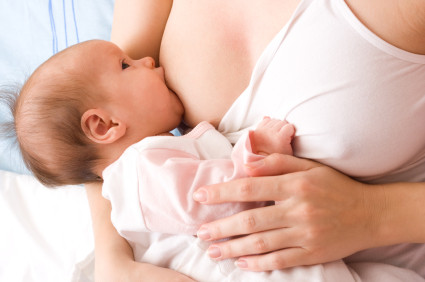Breast Milk Production Process (Pregnancy, After Birth) Composition
The glandular tissue of the female breast develops during puberty due to the action of estrogen. It is only during pregnancy that this entire development process is completed so that the glandular tissue can produce breast milk. The full breast milk production capacity, however, is only possible after birth.
Breast Milk Production During Pregnancy
The hormonal changes during pregnancy matures the glandular tissue of the breast. The number of alveoli (acini) increases as well as the fat quantity within the breast. Later in pregnancy, the matured glandular tissues are sufficiently developed to start producing breast milk.
Estrogen, progesterone and prolactin are the main hormones that regulate this developmental process along with other hormones like growth hormone, glucorticoids and even insulin. While elevated levels of estrogen and progesterone promote the maturation of the glandular tissue, prolactin is required to actually start the breast milk production process.In fact estrogen and progesterone inhibit breast milk production itself and only after birth, when the levels of estrogen and progesterone drop, can prolactin have its full effect on milk production. Therefore the breast milk production even in late pregnancy is very small.
Prolactin is secreted from the anterior pituitary and its milk producing effects are probably enhanced by human chorionic somatomammotropin from the placenta. However, it is also the placenta itself that secretes the milk-inhibiting estrogen and progesterone.
Types of Breast Milk
There are broadly three types of breast milk :
- Colostrum is a yellowish to cream colored substance that is high in protein but very low in fat compared to breast milk. It is also laden with immunological components and fat-soluble vitamins. It is present within the first few days after birth.
- Transitional milk is secreted during the latter stages of colostrum secretion and persist for between 10 days to 2 weeks until it is replaced by mature milk. It contains more fat and lactose than colostrum and has water-soluble vitamins.
- Mature milk is the type of milk will be present throughout lactation. The composition of mature milk is described below. Foremilk is first secreted when a baby starts to suckle and has a higher water content. It is then followed by hind-milk which is rich in carbohydrates, fats and protein.
Chemical Composition of Breast Milk
The composition of breast milk is as follows :
- Water : approximately 90%
- Carbohydrates (lactose) : approximately 6%
- Fat : approximately 3%
- Proteins (caesin, lactalbumins, etc) : approximately 1%
Other substances like the vitamins and minerals constitute less than 0.5% of breast milk. The composition of breast milk does vary slightly during lactation.
Breast Milk Production After Birth
After the birth of the baby, the levels of estrogen and progesterone drop. Colostrum, which is similar in composition to breast milk except that it has very low quantities of fat, is secreted a few days before and after birth. The quantity of colostrum available is small, almost 1% of that of the full breast milk capacity. Within a 10 days after birth, the breasts will start producing milk to nourish the infant (lactation).
Although the inhibiting action of estrogen and progesterone is removed after birth, prolactin which is essential for breast milk production also decreases in this time. However, the prolactin levels can be manipulated by nursing. When the baby suckles, nerves in the nipple relay signals to the hypothalamus to secrete thyrotropin-releasing hormone (TRH) and decrease the secretion of prolactin-inhibiting factor (PIF). TRH will stimulate the anterior pituitary to secrete prolaction, while PIF inhibits prolactin secretion. The anterior pituitary actually produces prolactin all the time but this is inhibited by the action of PIF. So when weaning, it is not the stimulation of TRH secretion that is the more significant deciding factor in prolactin secretion but rather the extent by which PIF is inhibited thereby allowing prolactin secretion to continue unabated.
During weaning, the prolactin secretion surges for about an hour. The surge is almost 10 to 20 times more than normal. However, in women who do not breastfeed, the prolactin secretion remains low and will return to the same levels as prior to pregnancy. Within a week of not breastfeeding, the glandular tissue can lose its ability to produce breast milk. This discontinues almost entirely by the seventh to ninth month after birth. It is however, not uncommon for women to lactate for years, even if there is just the odd suckling or stimulation.
Human Milk vs Cow’s Milk
Human milk is ideally suited for babies. It contains key components that are required for proper growth and development as is required by the human body.
Human milk contains more water and significantly greater amounts of lactose than cow’s milk. There is little difference in the fat content of human and cow’s milk if the fats are considered in total rather than the different types of fats. Cow’s milk however, has significantly more protein than human milk. The vitamin and mineral content in cow’s milk is much higher than in human milk but certain vitamins and minerals that are necessary for human development may be lacking in cow’s milk.
Cow’s milk, however, is not suitable for infants. It lacks some of the key immunological components that are required by the human infant and the foreign proteins may trigger allergic reactions in some babies. Cow’s milk should be avoided in babies and breast milk can be replaced or supplemented by appropriate milk supplements developed for infants.






